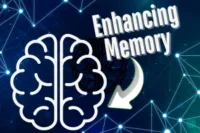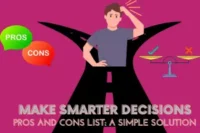10 Proven Techniques to Enhance Your Problem-Solving Skills
Published: 14/04/2025
Imagine trying to solve a puzzle without knowing what the finished picture looks like. It’s frustrating, right? You’re just guessing, trying to make pieces fit, but without a clear direction, you’re more likely to get lost along the way. Problem-solving in the workplace can feel just as confusing for many professionals. Without a structured approach, it’s easy to rely on gut instincts and trial and error, hoping something will work.
Problem-solving is one of the most valuable skills you can have today. Research by Questionmark shows that 63% of hiring managers now prioritize problem-solving skills over technical expertise. But while many of us know problem-solving is important, few have a clear system for tackling complex issues. Instead of relying on guesswork or instinct, a structured approach is key. Whether you’re solving a work problem, managing a team challenge, or making a business decision, systematic problem-solving is essential.
The good news? These skills aren’t just for top executives. Anyone can learn and improve them. What sets successful problem-solvers apart is their ability to follow a clear method, just like following the image on a puzzle box. In this article, we’ll walk you through 10 proven techniques that will give you a step-by-step guide to tackling any problem, helping you solve it with confidence and clarity.
Ready to take your problem-solving skills to the next level? Let’s dive in!
What Are Problem-Solving Skills?
Problem-solving skills refer to the ability to recognize and address issues effectively. It’s a crucial skill that helps individuals and teams find solutions to challenges in both personal and professional settings. It involves various stages, from identifying the problem to implementing a solution and evaluating its success.
Definition: Clear Explanation of What Constitutes Effective Problem-Solving
Effective problem-solving involves a systematic approach to tackle challenges. The process typically includes:
- Identifying the problem: Recognizing there is an issue that needs attention.
- Analyzing the causes: Understanding the root causes and context of the problem.
- Generating potential solutions: Brainstorming different ways to address the issue.
- Implementing the solution: Taking action to put the best solution into practice.
- Evaluating the outcome: Reviewing the effectiveness of the solution and learning from the experience.
Components: Breakdown of the Key Components of the Problem-Solving Process
Problem-solving consists of multiple stages, each essential for finding the best solution:
- Identification: Clearly recognizing the issue and defining its scope.
- Analysis: Investigating the causes and understanding the problem in-depth.
- Solution Generation: Brainstorming a range of potential solutions.
- Decision Making: Choosing the most feasible and effective solution.
- Implementation: Taking steps to carry out the solution.
- Evaluation: Reviewing results to determine success and areas for improvement.
Misconceptions: Address Common Misconceptions About Problem-Solving
Many people hold misconceptions about problem-solving. Let’s clear up a few:
- It’s purely intuitive: Problem-solving is not just about gut feelings. It’s a structured process requiring analysis and critical thinking.
- Only certain roles require it: Everyone needs problem-solving skills, whether you’re a manager, technician, or homemaker. It’s applicable in all aspects of life.
- It’s quick and easy: Effective problem-solving often takes time and effort, requiring careful thought and action.
Real-World Application: Examples of How Problem-Solving Applies Across Different Industries and Roles
Problem-solving skills are used in nearly every industry. Here are a few examples:
- Healthcare: Doctors and nurses must diagnose patients, determine treatments, and respond to medical emergencies.
- Business: Managers tackle operational issues, customer concerns, and team challenges to keep projects on track.
- Technology: Engineers and developers solve technical problems, optimize systems, and create solutions for improving efficiency.
- Everyday Life: From managing time to making decisions about home repairs, problem-solving helps people handle daily challenges.
Problem-solving is a versatile skill that touches nearly every part of work and life, making it indispensable for personal and professional growth.
Why Problem-Solving Skills Matter More Than Ever
With the constant changes happening around us, problem-solving skills are more crucial than ever. With increasing complexity in work environments and everyday life, the ability to identify, analyze, and resolve issues effectively is a key factor for success. These skills help individuals adapt to changes, overcome challenges, and make smarter decisions, both in professional and personal contexts.
Workplace Evolution: How Changing Work Environments Require Stronger Problem-Solving Abilities
As workplaces evolve with technology, remote work, and diverse teams, problem-solving skills are essential for staying ahead:
- Technological Change: With constant tech advancements, employees must solve technical issues and adapt to new tools.
- Remote Work: Solving problems without direct interaction requires creativity and effective communication.
- Diverse Teams: Working with people from different backgrounds requires finding common ground and solving conflicts.
These shifts demand a higher level of problem-solving to ensure that teams can collaborate efficiently and meet company goals.
Employer Perspective: Insights from Research Showing Why Employers Prioritize These Skills
Employers value problem-solving skills because they directly impact organizational performance. Research consistently shows that:
- Efficiency: Employees who can solve problems quickly and independently improve productivity.
- Innovation: Problem-solvers bring new ideas and approaches to overcome challenges.
- Leadership: Strong problem-solvers often rise to leadership roles, as they can guide teams through tough situations.
Employers seek individuals who can think critically and find solutions in a variety of scenarios, making these skills highly sought after.
Career Advancement: How Strong Problem-Solving Skills Can Accelerate Career Growth
Problem-solving skills are crucial for climbing the career ladder:
- Increased Responsibility: Being able to solve complex problems often leads to higher positions and more responsibilities.
- Leadership Opportunities: Problem-solvers tend to be seen as leaders, which opens doors to managerial roles.
- Recognition and Rewards: Employees who can tackle challenges and deliver results are often rewarded with promotions and raises.
Having strong problem-solving abilities makes you stand out in the workplace, creating more opportunities for career growth and advancement.
Personal Benefits: Beyond Work, How These Skills Improve Decision-Making in All Areas of Life
Problem-solving skills are not just for work—they help in everyday life too:
- Better Decision-Making: Whether it’s choosing a new car or managing finances, problem-solving helps you evaluate options and make informed decisions.
- Conflict Resolution: These skills help in resolving conflicts with friends, family, and colleagues, leading to healthier relationships.
- Improved Time Management: With better problem-solving, you can handle unexpected challenges and plan your time more effectively.
Ultimately, mastering problem-solving skills benefits all areas of life, making you more capable of handling the ups and downs.
Technique 1: Structured Problem Definition
Concept: The Importance of Clearly Defining the Problem Before Attempting to Solve It
Before jumping into solutions, it’s essential to first understand the problem in its entirety. Clearly defining the issue helps avoid misdirected efforts and ensures that the right problem is being addressed. A structured problem definition prevents wasted time and resources on solutions that don’t effectively address the core issue.
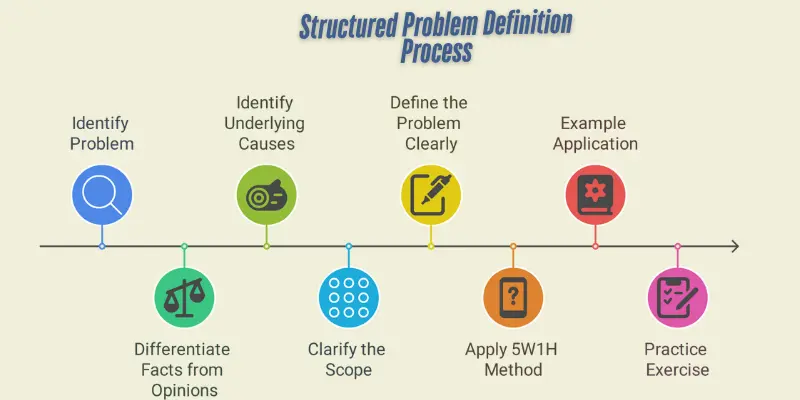
Process: Step-by-Step Approach to Defining Problems
To define a problem properly, follow these steps:
- Differentiate Facts from Opinions: Gather factual data and avoid assumptions or biases.
- Identify Underlying Causes: Look beyond surface symptoms to understand the root cause.
- Clarify the Scope: Determine the extent of the problem, and what’s impacted by it.
- Define the Problem Clearly: Write a precise statement that encapsulates the issue without ambiguity.
Tools: Introduce Tools Like the “5W1H” Method
The 5W1H method is an effective tool for problem definition:
- Who: Who is affected by the problem?
- What: What is the problem?
- When: When did the problem start, and how long has it been happening?
- Where: Where is the problem occurring?
- Why: Why is this problem happening? What are the contributing factors?
- How: How is the problem affecting operations or outcomes?
This method helps ensure all aspects of the problem are considered.
Example: Real-World Example of How Proper Problem Definition Led to an Effective Solution
Consider a manufacturing company facing delays in production. Initially, the team thought the problem was machinery failure. However, by applying a structured problem definition, they identified that the real issue was a lack of proper scheduling and resource allocation. Once the problem was properly defined, they implemented a solution that focused on optimizing scheduling processes, significantly reducing delays.
Application Exercise: Simple Activity Readers Can Try to Practice Structured Problem Definition
To practice this technique:
- Pick a problem you are currently facing (at work or in personal life).
- Use the 5W1H method to define the problem in detail.
- Break down the problem into smaller components to see what is fact versus opinion.
- Write a clear and concise problem statement.
- Reflect on whether the problem definition aligns with the real issue and adjust as needed.
This exercise will help sharpen your ability to define problems before jumping to conclusions or solutions.
Technique 2: Root Cause Analysis
Concept: Understanding the Difference Between Symptoms and Root Causes
Root cause analysis is the process of identifying the true, underlying cause of a problem, not just addressing the symptoms. While symptoms are the visible issues, the root cause is the deeper, often hidden problem that leads to those symptoms. Understanding this distinction helps to create more effective and lasting solutions, rather than just treating temporary fixes.
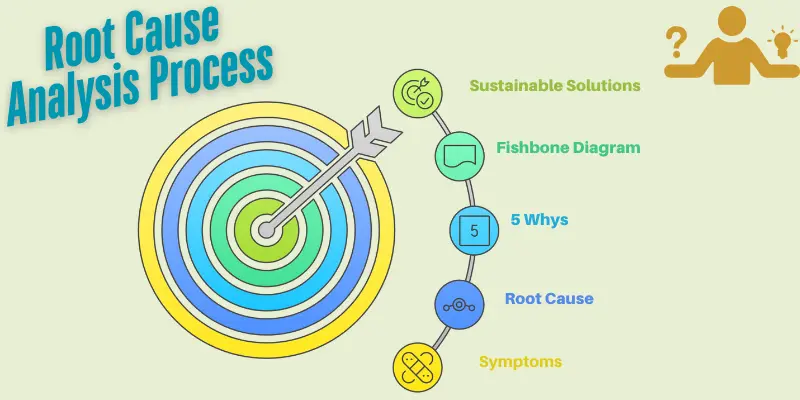
Process: How to Dig Deeper to Find Underlying Issues Using Methods Like the “5 Whys”
To perform a root cause analysis, follow these steps:
- Ask “Why”: Start by asking “Why?” to get to the underlying issue.
- For example, if there’s a delay in a project, ask why it happened.
- Repeat the Question: Keep asking “Why?” at least five times. Each answer should bring you closer to the root cause, helping you go beyond the surface problem.
- Dig Deeper: Continue this process until you reach a fundamental cause that can be addressed effectively.
Tools: Introduction to Fishbone Diagrams and Other Root Cause Analysis Tools
Two common tools for root cause analysis are:
- Fishbone Diagram: Also known as the Ishikawa diagram, it helps visually map out potential causes of a problem in categories like people, processes, equipment, or materials. This visual representation can help identify patterns and connections.
- 5 Whys: As mentioned, this simple technique involves repeatedly asking “Why?” to peel back layers of the issue.
Both tools guide you through the analysis process to pinpoint the real cause.
Example: Case Study Showing How Root Cause Analysis Prevented Recurring Problems
A retail company faced frequent stockouts, causing customer dissatisfaction. Initially, they assumed the problem was due to poor inventory management. However, using root cause analysis, they discovered that the true cause was inaccurate forecasting methods. By addressing the forecasting process, they were able to significantly reduce stockouts, improving customer satisfaction and operational efficiency.
Application Exercise: Guide to Conducting a Basic Root Cause Analysis on a Current Challenge
To practice root cause analysis, follow these steps:
- Identify a current problem you’re facing (work or personal).
- Ask “Why?” and answer the question based on the immediate cause.
- Repeat the “Why?” question at least five times, each time digging deeper.
- Create a fishbone diagram to visualize the potential causes.
- Once you’ve reached the root cause, brainstorm potential solutions that target it directly.
This exercise will help you apply root cause analysis in real-world situations and find more sustainable solutions.
Technique 3: Creative Solution Generation
Concept: The Value of Developing Multiple Potential Solutions Before Selecting One
Creative solution generation emphasizes the importance of considering a variety of options before settling on a solution. It helps you avoid focusing on just one idea and encourages you to think outside the box. By exploring different possibilities, you increase the chances of finding the most effective and innovative solution to the problem at hand.
Process: Techniques for Brainstorming and Generating Diverse Solution Options
To generate creative solutions, use these steps:
- Brainstorming: Gather ideas freely, without judgment, to create a wide range of possible solutions.
- Build on Ideas: Don’t settle for the first idea—let others inspire new thoughts and approaches.
- Evaluate: After generating multiple ideas, assess their feasibility and potential impact.
- Select: Choose the solution that best fits the problem and is most achievable.
Tools: Introduction to Methods Like Mind Mapping, SCAMPER, and Reverse Thinking
Several creative techniques can help you generate diverse solutions:
- Mind Mapping: A visual tool that connects ideas, allowing you to explore different aspects of the problem and potential solutions.
- SCAMPER: A technique that encourages you to think about solutions by asking questions related to Substitute, Combine, Adapt, Modify, Put to another use, Eliminate, and Reverse.
- Reverse Thinking: Consider the opposite of the obvious solution to uncover new approaches and possibilities.
Example: How a Company Used Creative Solution Generation to Solve a Persistent Issue
A software company struggled with recurring bugs in their application. Initially, they fixed the bugs one by one, but the problem persisted. By applying creative solution generation, they brainstormed new approaches such as implementing automated testing and involving users in the feedback process earlier. This shift led to a more permanent solution that addressed the root cause of the bugs.
Application Exercise: Brainstorming Activity to Practice Generating Multiple Solutions
To practice generating creative solutions:
- Choose a current challenge you’re facing.
- Use mind mapping to jot down ideas related to solving the issue.
- Apply SCAMPER to each idea, asking how you can alter or improve it.
- Use reverse thinking to consider what would make the problem worse and how to avoid it.
- Narrow down your options to the most promising solutions and evaluate them.
This activity will help you get comfortable with generating diverse solutions and exploring unconventional ideas.
Technique 4: Critical Thinking
Concept: The Role of Systematic Evaluation and Logical Reasoning in Problem-Solving
Critical thinking involves analyzing and evaluating information in a structured, logical way to make better decisions. It helps you avoid snap judgments and enables you to approach problems with a clear and objective mindset. By questioning assumptions and considering multiple perspectives, critical thinking leads to more informed and effective solutions.
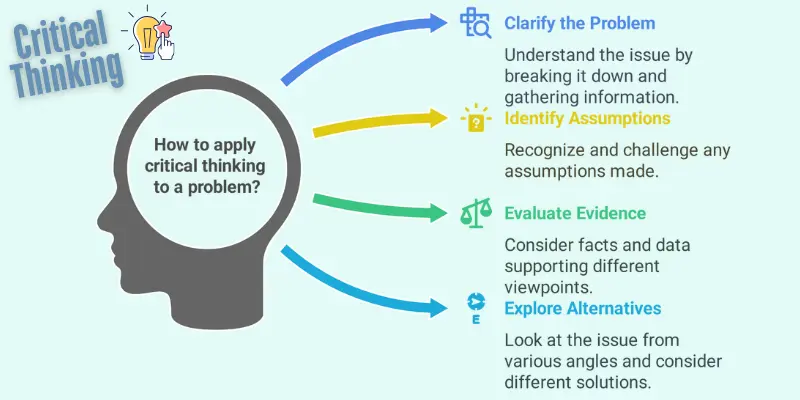
Process: Framework for Applying Critical Thinking to Problem Analysis
To apply critical thinking effectively, follow these steps:
- Clarify the Problem: Ensure you fully understand the problem by breaking it down and gathering relevant information.
- Identify Assumptions: Recognize any assumptions you or others may have, and challenge them.
- Evaluate Evidence: Consider the facts and data supporting different viewpoints.
- Explore Alternatives: Look at the issue from different angles and consider a variety of solutions.
- Make a Decision: Use logical reasoning to choose the best course of action based on your analysis.
Tools: Cognitive Bias Checklist and Critical Questioning Techniques
Several tools help enhance your critical thinking:
- Cognitive Bias Checklist: A list of common biases (like confirmation bias or anchoring bias) that can distort your thinking. Being aware of them helps you make more objective decisions.
- Critical Questioning: Ask questions like “What’s the evidence?”, “What are the alternatives?”, and “What are the implications of this decision?” to dig deeper into the problem.
Example: How Critical Thinking Helped Avoid a Major Decision Error
A team at a consulting firm was deciding whether to expand into a new market. Initially, they relied on optimistic projections without challenging assumptions. By applying critical thinking, they asked more questions, reviewed evidence, and considered alternative markets. This led them to realize that the new market was over-saturated, and they avoided a costly mistake.
Application Exercise: Critical Thinking Questions to Apply to a Current Problem
To practice critical thinking:
- Identify a current problem you’re dealing with.
- Ask yourself:
- What evidence do I have to support my view?
- What assumptions am I making?
- What alternative solutions have I considered?
- Reassess the problem from different perspectives and test your reasoning.
- Reflect on whether your decision process has been influenced by bias or emotions.
This exercise will help you develop stronger critical thinking skills and improve your decision-making process.
Technique 5: Decision Matrix Evaluation
Concept: Using Objective Criteria to Evaluate and Select the Best Solution
A decision matrix helps you make more informed and objective decisions by comparing different options based on specific criteria. It’s a tool that eliminates personal bias and allows you to evaluate solutions in a clear, systematic way. By assigning values to each option, you can select the best solution that meets your needs and goals.
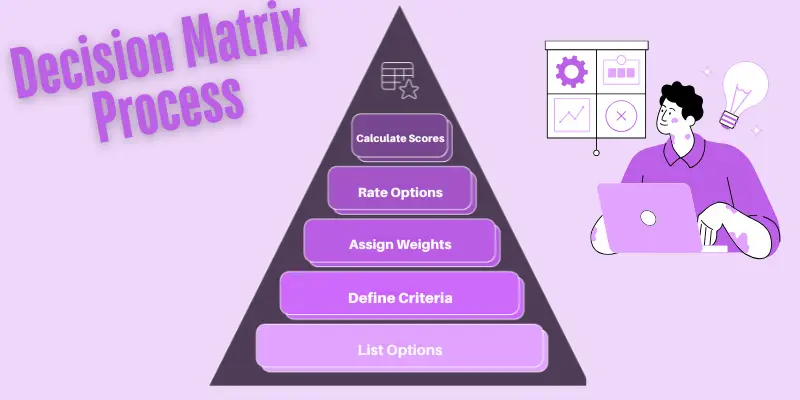
Process: How to Create and Use a Decision Matrix
Follow these steps to create a decision matrix:
- List Options: Write down all the possible solutions you’re considering.
- Define Criteria: Identify the factors that are important for making the decision (e.g., cost, time, effectiveness).
- Assign Weights: Give each criterion a weight based on its importance to you (e.g., 1-5 scale).
- Rate Options: Rate each option against the criteria using a consistent scale.
- Calculate Scores: Multiply the ratings by the weights and add up the scores for each option. The option with the highest score is the best choice.
Tools: Templates and Scoring Systems for Solution Evaluation
To help you create a decision matrix, consider using:
- Decision Matrix Templates: Simple spreadsheets or tools like Excel can help you set up a matrix quickly.
- Scoring Systems: Use a consistent scoring scale (e.g., 1 to 5) to rate options objectively. You can adjust the scoring scale to suit the specific decision-making context.
Example: Case Study of Effective Decision Matrix Use in a Business Context
A company was deciding whether to invest in a new software platform. They created a decision matrix with criteria such as cost, ease of use, scalability, and customer support. After rating each software option and calculating the scores, the matrix clearly showed which platform would best meet their needs, helping them make a more informed and objective decision.
Application Exercise: Creating a Simple Decision Matrix for a Personal or Professional Decision
To practice using a decision matrix:
- Choose a current decision you’re facing (e.g., purchasing a new gadget, choosing a project path).
- List the options available to you.
- Identify the criteria that matter most for your decision (e.g., price, quality, time).
- Rate each option based on your criteria using a consistent scale.
- Calculate the total scores and evaluate which option has the highest score.
This exercise will help you make more objective and structured decisions, especially when you have multiple factors to consider.
Technique 6: Strategic Implementation Planning
Concept: The Importance of Detailed Planning for Solution Implementation
Strategic implementation planning ensures that a solution is not only chosen but also executed successfully. Without a detailed plan, even the best solution can fail due to poor execution. A well-thought-out implementation plan provides clear steps, assigns responsibilities, and sets timelines, which helps ensure the solution is carried out efficiently and effectively.
Process: Steps to Create an Effective Implementation Plan
To create an effective implementation plan, follow these steps:
- Define Goals: Clearly outline the objectives you want to achieve with the solution.
- Set Milestones: Break the implementation process into smaller, manageable phases or milestones.
- Assign Responsibilities: Identify who will be responsible for each task or milestone.
- Establish Timelines: Set realistic deadlines for each phase of the plan.
- Monitor Progress: Regularly track the progress and make adjustments as needed to stay on track.
Tools: Implementation Planning Templates and Checklists
To make the planning process easier, use these tools:
- Implementation Planning Templates: Use pre-made templates in tools like Excel or project management software to organize tasks, responsibilities, and timelines.
- Checklists: Create checklists to ensure that no steps are overlooked during implementation. This helps keep the process on track and ensures consistency.
Example: Success Story of Well-Executed Implementation Planning
A manufacturing company wanted to introduce a new inventory management system. They developed a detailed implementation plan that included clear goals, responsibilities, and timelines. By sticking to the plan, they were able to integrate the new system smoothly, reduce inventory errors by 20%, and improve efficiency. The structured approach ensured that all team members were on the same page, and potential challenges were anticipated and managed in advance.
Application Exercise: Template for Creating an Implementation Plan
To create your own implementation plan:
- Define the Solution: Write a clear description of the solution you’re implementing.
- Set Clear Objectives: List the outcomes you want to achieve.
- Break the Plan into Phases: Identify major milestones and tasks to complete.
- Assign Roles and Responsibilities: Clearly define who will handle each task.
- Create a Timeline: Set dates for each milestone and task completion.
- Track Progress: Set up a system to monitor the progress regularly.
This exercise will help you organize and structure your approach to implementing any solution, ensuring that you stay on track and achieve your goals.
Technique 7: Adaptability in Problem-Solving
Concept: The Necessity of Remaining Flexible When Circumstances Change
Adaptability in problem-solving is about being open to changes and adjusting your approach when unexpected challenges arise. While a structured plan is important, the ability to pivot when things don’t go as expected is what helps achieve long-term success. Being adaptable ensures you can find new solutions quickly and stay on course despite obstacles.
Process: How to Build Adaptability into Your Problem-Solving Approach
To develop adaptability, follow these steps:
- Embrace Change: Accept that things will not always go as planned and be prepared to adjust.
- Monitor the Situation: Continuously assess the problem and its context to identify any changes.
- Maintain Flexibility: Keep an open mind about alternative solutions and be willing to shift direction when needed.
- Stay Calm Under Pressure: Managing stress allows you to think clearly and make adjustments without panic.
Tools: Techniques for Scenario Planning and Contingency Development
Use these tools to build adaptability into your problem-solving:
- Scenario Planning: Imagine different possible outcomes and develop strategies for each scenario. This helps you prepare for unexpected events.
- Contingency Development: Have backup plans in place in case things don’t go according to your initial plan. This ensures you’re not caught off guard when challenges arise.
Example: How Adaptability Saved a Project When Unexpected Challenges Arose
A tech company was working on a new software update when a key team member left the project unexpectedly. Instead of panicking, the team quickly adapted by redistributing tasks, finding new resources, and adjusting the timeline. Their adaptability allowed them to keep the project on track and ultimately deliver the software with minimal delays.
Application Exercise: Identifying Potential Changes That Might Affect a Current Solution
To practice adaptability:
- Look at a current project or solution you’re working on.
- List potential changes or challenges that could arise (e.g., resource limitations, unexpected delays, changing requirements).
- For each potential change, develop a contingency plan or backup solution.
- Reflect on how flexible your approach is and whether there are areas where you could adjust more easily if needed.
This exercise helps you anticipate challenges and prepare for changes, increasing your ability to adapt quickly and effectively.
Technique 8: Collaborative Problem-Solving
Concept: Leveraging Diverse Perspectives and Expertise for Better Solutions
Collaborative problem-solving brings together people with different skills, experiences, and viewpoints to tackle challenges. By combining various perspectives, teams can develop more creative and well-rounded solutions. This approach encourages shared ownership and improves the quality of decision-making, as it takes advantage of the collective knowledge and creativity of the group.
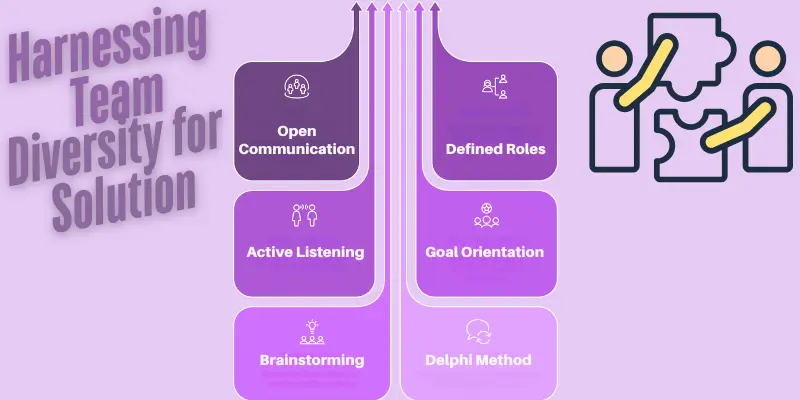
Process: How to Effectively Collaborate on Problem-Solving
To collaborate effectively:
- Encourage Open Communication: Ensure that everyone feels comfortable sharing their ideas and opinions.
- Define Roles Clearly: Assign specific tasks and responsibilities to team members based on their expertise.
- Foster Active Listening: Make sure team members actively listen to each other, helping to build understanding and trust.
- Stay Goal-Oriented: Keep the focus on the problem at hand and the ultimate goal, while avoiding distractions.
Tools: Frameworks for Group Problem-Solving Sessions
Several frameworks can help guide collaborative problem-solving:
- Brainstorming: A method for generating a wide range of ideas without judgment, followed by selecting the best options.
- Nominal Group Technique (NGT): A structured approach that encourages equal participation by having each member contribute ideas anonymously before discussing.
- Delphi Method: A consensus-building process where team members share their ideas iteratively and refine solutions through rounds of feedback.
Example: How a Cross-Functional Team Solved a Complex Problem Through Collaboration
A retail company faced issues with its inventory management system, leading to frequent stockouts and overstocking. A cross-functional team consisting of logistics, IT, and customer service members was formed. By bringing diverse perspectives and expertise together, they identified a gap in communication between departments and implemented a new automated system. Their collaborative approach led to smoother operations and reduced errors in inventory management.
Application Exercise: Planning a Collaborative Problem-Solving Session
To practice collaborative problem-solving:
- Identify a problem that requires a team approach to solve.
- Select a diverse group of people with different areas of expertise.
- Define the problem clearly and outline the goal of the session.
- Use a framework like brainstorming to generate ideas and solutions.
- Assign roles and responsibilities during the session to ensure active participation.
- Review the ideas and choose the best solution through group discussion or voting.
This exercise will help you effectively harness the power of collaboration and ensure that multiple perspectives contribute to finding the best solution.
Technique 9: Emotional Intelligence in Problem-Solving
Concept: Managing Emotions and Understanding Others During the Problem-Solving Process
Emotional intelligence (EI) plays a vital role in problem-solving by helping individuals manage their own emotions and understand others’ feelings during the process. High EI enables you to stay calm under pressure, build stronger relationships with team members, and make decisions that consider both logical reasoning and emotional perspectives, ultimately leading to better solutions.
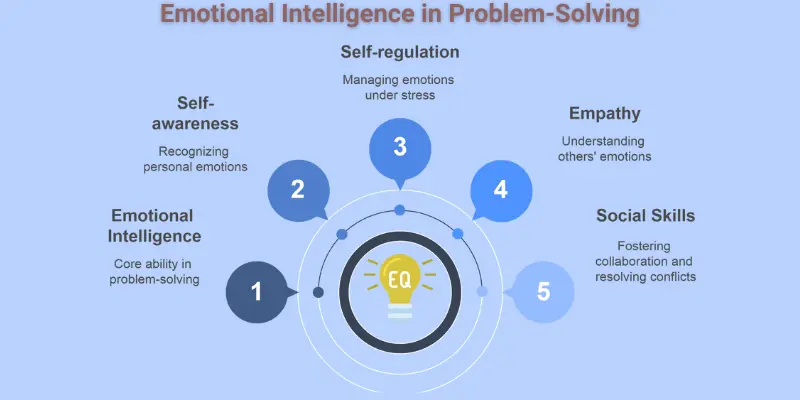
Process: Integrating Emotional Awareness into Each Problem-Solving Stage
To integrate emotional intelligence effectively:
- Self-awareness: Recognize and understand your own emotions and how they may influence your thinking and decision-making.
- Self-regulation: Manage your emotions by staying calm, composed, and focused during problem-solving, especially under stress.
- Empathy: Pay attention to others’ emotions, listening actively to their concerns and perspectives.
- Social Skills: Use your understanding of others’ emotions to foster collaboration and resolve conflicts in a positive, productive way.
Tools: Emotional Regulation Techniques and Empathy-Building Exercises
To improve emotional intelligence:
- Emotional Regulation Techniques: Practice mindfulness, deep breathing, or meditation to help manage stress and emotional responses.
- Empathy-Building Exercises: Engage in activities that help you connect with others’ emotions, such as perspective-taking exercises or active listening drills.
Example: How Emotional Intelligence Prevented Conflict During a Challenging Problem-Solving Situation
During a project meeting, a team faced disagreements over how to approach a tight deadline. By applying emotional intelligence, the team leader remained calm and empathetic, acknowledging the stress members were under. This helped diffuse tension and allowed the team to work together to create a realistic plan, leading to a successful project completion without major conflict.
Application Exercise: Self-Assessment of Emotional Responses to Problems
To practice emotional intelligence in problem-solving:
- Reflect on a recent problem you faced and your emotional response.
- Identify what emotions you felt during the situation and how they may have affected your approach.
- Consider how your emotions influenced others and how you could have managed them better.
- Practice self-regulation techniques like deep breathing or taking a break when emotions arise.
- Evaluate how understanding others’ emotions might have improved the solution or team dynamic.
This exercise will help you become more aware of your emotional responses and improve your ability to manage them in problem-solving situations.
Technique 10: Continuous Learning and Improvement
Concept: The Importance of Learning from Both Successes and Failures
Continuous learning is key to improving your problem-solving abilities. It involves reflecting on both your successes and failures to identify areas for improvement. Embracing a growth mindset allows you to constantly evolve your skills, learn from experiences, and apply those lessons to future challenges, ultimately enhancing your problem-solving effectiveness.
Process: Creating Feedback Loops and Reflection Practices
To foster continuous learning:
- Seek Feedback: Actively ask for feedback from colleagues, mentors, or peers on your problem-solving approach.
- Reflect Regularly: Set aside time to reflect on your actions and decisions after each problem-solving experience.
- Identify Lessons Learned: Analyze what worked well and what didn’t, and use that information to adjust your approach for the future.
- Make Adjustments: Implement changes based on your reflections and feedback to improve your future problem-solving.
Tools: After-Action Review Templates and Learning Journals
Use these tools to enhance your learning process:
- After-Action Review Templates: A structured format that helps you assess what happened, why it happened, and how you can improve for next time.
- Learning Journals: Keep a journal to document your problem-solving experiences, track progress, and reflect on what you’ve learned.
Example: How a Learning Mindset Transformed One Organization’s Problem-Solving Culture
A tech company struggled with high employee turnover and low morale. After adopting a learning mindset, they encouraged employees to review past projects and failures, identifying key takeaways. This process helped the team improve processes and address internal challenges, ultimately boosting employee engagement and retention.
Application Exercise: Reflection Questions for Evaluating Problem-Solving Effectiveness
To practice continuous learning:
- What problem did I solve, and how did I approach it?
- What were the outcomes, and were they what I expected?
- What went well during the process? What could have been done differently?
- Did I involve others in my problem-solving, and how did their input shape the solution?
- What did I learn from this experience, and how can I apply it to future challenges?
This exercise helps you evaluate your problem-solving process and identify areas for growth, ensuring that you keep improving over time.
Common Mistakes to Avoid
Rushing to Solutions: The Danger of Skipping Proper Problem Definition and Analysis
- Why It’s a Mistake: Jumping straight into a solution without fully understanding the problem often leads to ineffective or incomplete fixes.
- The Right Approach: Take the time to define the problem clearly and analyze it before seeking solutions. A thorough understanding of the issue ensures that the solution addresses the root cause.
Single-Solution Thinking: Limiting Yourself to the First Idea That Comes to Mind
- Why It’s a Mistake: Settling for the first solution that seems reasonable can lead to missed opportunities and less effective outcomes.
- The Right Approach: Explore multiple solutions before deciding. Brainstorm different ideas and evaluate their pros and cons to find the best fit for the problem.
Analysis Paralysis: Getting Stuck in Endless Data Gathering Without Making Decisions
- Why It’s a Mistake: Over-analyzing data or gathering endless information can delay decisions and prevent action.
- The Right Approach: Set a deadline for decision-making and focus on gathering enough relevant data to make an informed choice. Trust the process and avoid overthinking.
Ignoring Implementation Challenges: Failing to Plan for the Realities of Executing Solutions
- Why It’s a Mistake: It’s easy to overlook the practical aspects of putting a solution into action, leading to unforeseen obstacles and delays.
- The Right Approach: Ensure your solution is practical by thoroughly planning the implementation stage, considering factors like time, resources, and potential obstacles.
Neglecting Feedback: Not Learning from Outcomes to Improve Future Problem-Solving
- Why It’s a Mistake: Failing to review and learn from previous decisions can prevent growth and improvement in problem-solving.
- The Right Approach: Regularly seek feedback and evaluate the results of your solutions. Use these insights to adjust your approach and enhance your future problem-solving effectiveness.
- Problem-solving skills have become the most sought-after competency in today’s workplace
- A systematic approach combining analytical thinking, creativity, and emotional intelligence yields the best results
- The ten techniques in this guide provide a comprehensive toolkit for addressing any challenge
- Regular practice and reflection are essential for developing problem-solving mastery
- These skills create value in all aspects of life, not just professional settings
Conclusion: Mastering Problem-Solving Skills for Professional and Personal Success
Problem-solving is more than just a workplace skill; it’s a life skill that helps you tackle challenges in all areas, from your career to personal decisions. As we’ve seen in this guide, problem-solving is no longer a “nice-to-have” skill but a crucial one. Employers now look for it just as much as technical expertise, and for good reason—it helps drive success in any situation.
The Power of Systematic Problem-Solving
The ten techniques we covered give you a practical, structured way to approach any problem, no matter how big or small:
- Structured Problem Definition helps you clarify what the issue is before rushing to find a solution.
- Root Cause Analysis digs deeper to address the real issue, not just the surface-level symptoms.
- Creative Solution Generation encourages you to think beyond the obvious answers and find fresh solutions.
- Critical Thinking allows you to assess information logically and avoid biases that could cloud your judgment.
- Decision Matrix Evaluation gives you a clear, objective way to compare options.
- Strategic Implementation Planning helps you turn ideas into action with clear steps.
- Adaptability makes sure you’re ready to adjust when things don’t go as planned.
- Collaborative Problem-Solving brings together diverse perspectives for better results.
- Emotional Intelligence ensures you handle the human side of problem-solving with care.
- Continuous Learning turns every challenge into an opportunity to grow.
What makes these techniques so effective is that they can be applied to a wide variety of challenges. Whether you’re working through a technical issue, dealing with a team conflict, or making a tough business decision, these tools help you tackle problems methodically and with confidence.
Beyond the Workplace: Problem-Solving in Everyday Life
While these techniques are invaluable at work, their benefits stretch far beyond the office. The same problem-solving skills you use at work can help you make better decisions in your personal life—whether you’re managing finances, resolving family conflicts, or planning for the future. The ability to think through problems and find effective solutions can make life’s challenges easier to handle.
From Knowledge to Action: Your Next Steps
Now that you’ve learned about these techniques, it’s time to put them into practice. Here’s how you can start:
- Start small: Pick one technique that resonates with you and use it to solve a current challenge.
- Build your toolkit: As you get more comfortable, add another technique to your problem-solving toolbox.
- Seek feedback: Ask colleagues or mentors to share their thoughts on how you’re approaching problems.
- Reflect on your results: After trying a solution, look back at what worked and what didn’t to learn and improve.
- Share with others: Teaching these techniques to someone else can help you solidify your understanding.
Becoming a great problem-solver isn’t about avoiding mistakes—it’s about approaching challenges with a clear process, learning from each experience, and becoming more confident with time.
Your Problem-Solving Journey
Remember, the journey to mastering problem-solving doesn’t end here. Every challenge is an opportunity to learn and improve. The more you practice these techniques, the better you’ll get at finding solutions—whether they’re big or small. So, what’s the next problem you’re going to solve, and which technique will you try first? The answers to those questions are the first step in transforming you into the problem-solver you want to be.
Frequently Asked Questions: Problem-Solving Techniques
Problem-solving is a skill that anyone can learn and get better at over time. While some people might naturally be more analytical or creative, what truly sets great problem-solvers apart is their ability to use specific methods and strategies. The ten techniques shared in this article offer a clear, step-by-step approach that anyone—no matter their background—can pick up, practice, and master as they go.
Although they’re closely connected, problem-solving and critical thinking have distinct roles. Critical thinking is about analyzing information, evaluating evidence, and making logical decisions—it’s a key part of problem-solving. On the other hand, problem-solving is a broader process that includes not just analysis (critical thinking) but also identifying the problem, brainstorming solutions, making decisions, planning how to implement those solutions, and reviewing the results. Think of critical thinking as an essential tool that helps you navigate the entire problem-solving process.
These techniques are just as useful for personal challenges as they are for professional ones. Whether you’re making a big career decision, working through a family disagreement, planning a major purchase, or dealing with health concerns, the same structured methods can guide you to better decisions. Their step-by-step approach helps minimize emotional biases and brings clarity to any situation where you’re facing tough choices or challenges.
You can start seeing improvement in your problem-solving skills fairly quickly, but true mastery takes time and practice. Many people notice noticeable progress within 2-3 months of consistently using these techniques to tackle real-world problems. The key is to apply them regularly—pick one technique that feels right for you, use it on a current challenge, review what worked, and then add more techniques as you go. Consistency is what makes the difference.
No, you don’t need any special tools or software to get started with these techniques. Most can be applied using simple tools like spreadsheets, word processors, or even just pen and paper. The article provides templates and frameworks that you can easily create on your own without the need for specialized software. As you get more comfortable with the techniques, you might choose to explore tools like mind mapping software, decision matrix tools, or project management platforms to further enhance your problem-solving process.
The right technique depends on where you are in the problem-solving process and the type of challenge you’re facing:
- For unclear or complex problems: Start with Structured Problem Definition and Root Cause Analysis.
- When you need creative solutions: Use Creative Solution Generation techniques.
- When comparing multiple options: Apply the Decision Matrix Evaluation.
- When putting solutions into action: Focus on Strategic Implementation Planning.
- When collaborating with others: Use Collaborative Problem-Solving and Emotional Intelligence.
- When things are changing: Focus on Adaptability in Problem-Solving.
For most complex problems, using a combination of techniques in sequence will help guide you through the entire problem-solving process.

- Be Respectful
- Stay Relevant
- Stay Positive
- True Feedback
- Encourage Discussion
- Avoid Spamming
- No Fake News
- Don't Copy-Paste
- No Personal Attacks



- Be Respectful
- Stay Relevant
- Stay Positive
- True Feedback
- Encourage Discussion
- Avoid Spamming
- No Fake News
- Don't Copy-Paste
- No Personal Attacks



